Shortly after graduation from Grinnell, Martha Grodzins Butt ’64 and one of her classmates, Livija Denavs-Rebane ’64, stepped onto the tarmac at the airport in Chiang Mai, Thailand, with flower garlands around their necks and smiles on their faces. Howard Bowen, then president of Grinnell College, had arranged for a Grinnell alum to meet them in every city where they landed en route to Thailand: Honolulu, Tokyo, Hong Kong, and Bangkok. They had spent a memorable evening in Honolulu, danced at a Tokyo nightclub, learned about housing issues in Hong Kong, and arrived in Thailand ready for whatever came next.
Martha planned to teach there for one year, but she met and fell in love with another teacher, John Butt. They married, and in the nearly 60 years since, have lived and worked in Massachusetts and Minnesota in the United States and in Japan and Thailand abroad. They have now lived in Thailand for four decades. From the beginning, she has made it a point to stay connected with her fellow Grinnellians.
In the 1960s, that required patience and determination. “When I first came here, we had to go to the post office to make a telephone call,” Butt says. Today, internet communication is faster and easier, but maintaining and growing a sense of community, especially when living internationally, takes initiative. It may require work, she says, but the payoff is great.
We asked a few international alumni how they maintain their Grinnell connections, even thousands of miles from campus.
 Martha Butt
Martha Butt
Chiang Mai, Thailand
“I think Grinnell’s special,” Butt says. “I had so many wonderful experiences.”
Butt says her impressive network of connections is part of the Grinnell magic. “I think that’s a unique thing that only some small liberal arts colleges can offer.”
Butt has stayed tight with a group of 10 women from her class. They hold their own reunions, and for many years, they sent a round robin letter from one woman to the next, each adding her own news before sending it on. The full circuit could take an entire year.
They enjoy traveling together, and when the COVID-19 pandemic stopped travel, they set up regular Zoom gatherings. Who knows where they’ll go next? There’s no doubt, however, that they will stay in touch.
Butt’s career in international education has also kept her connected with Grinnellians. About 15 years ago, she encouraged Grinnell to include Thailand in Grinnell Corps. “I had wonderful students,” she says. “I’m very close to them.”
The program is important to her because she first came to Thailand in 1964 on Grinnell’s Fifth Year Global Service Scholarship. In addition to staying in contact with the recent Grinnell Corps group, Butt has reconnected with Grinnellians who served in Thailand in the Grinnell Corps program of the ’60s.
Her list of Grinnell connections goes on and on. For instance, when she visits her grandchildren in Arlington, Virginia, she meets up with the Grinnell Lunch Bunch in Washington, D.C.
Her network even extends to Grinnell presidents, from Bowen to George Drake ’56 to Anne Harris. She wrote a letter to Drake shortly before he died. “I didn’t expect him to write back,” she says. “He had cancer, and yet, he wrote.”
These Grinnell connections don’t fade away, Butt says. “We always feel like we’re just picking up where we left off.”
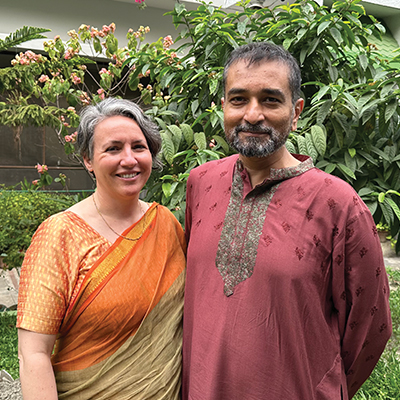 Wendy Werner and Iftekar Ahmed
Wendy Werner and Iftekar Ahmed
New Delhi, India
Wendy Werner ’96 met one of her closest Grinnell friends in the pool at the American Club in Dhaka, Bangladesh. “We both had new babies,” she says. “We were just chatting and found a lot in common.” As they shared their life stories, they discovered their Grinnell connection.
Werner and her husband Iftekar Ahmed ’96 now live and work in New Delhi, India. Werner’s career at the International Finance Corporation has taken them from Bangladesh to Tajikistan, Belgrade, Vietnam, and now India. “Each place has been a new challenge in everyday practical life,” she says. Ahmed has been the support mechanism that has made her career at IFC possible, Werner says.
Ahmed is from Bangladesh, while Werner was an “Air Force brat” who lived all over. She attended high school in the U.K. and learned to adapt to new cultures at an early age. But she had never been to Iowa. “Neither of us visited Grinnell before enrolling,” she says.
Coming from a city of more than 10 million people, the quiet streets of Grinnell were a shock for Ahmed. “I thought there was perhaps a curfew due to civil unrest,” he says.
Today, although far from Iowa, Ahmed and Werner are part of a close-knit group of Grinnellians. They’ve extended their network to include Grinnellians in the countries where they have lived. “The further from Iowa, perhaps the stronger our Grinnell connection,”
Werner says. “We consider our Grinnell network as close as family.”
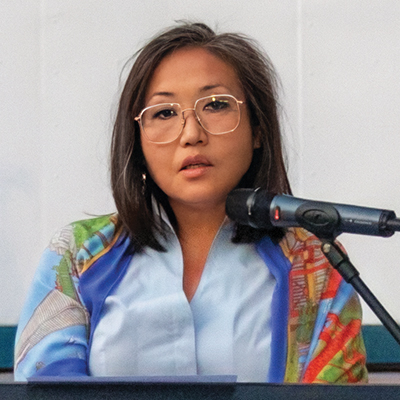 Elizabeth Lee
Elizabeth Lee
Thessaloniki, Greece
Even in childhood, Elizabeth Lee’s (’99) life experiences were preparing her for a diplomatic career in the Foreign Service. Originally from California, she spent many summers visiting her grandparents in South Korea. “Being steeped in two cultures and negotiating the differences between the two gave me important life skills, such as adaptability, respect for different cultures, as well as curiosity about the larger world,” Lee says.
U.S. Consul General Lee, now stationed in Thessaloniki, Greece, has spent 16 years in the Foreign Service, with postings in Seoul, Jerusalem, Baghdad, and more.
“Adapting to new cultures can be challenging, but living in different countries and seeing the world is also one of the huge upsides of this job,” Lee says. “Each new posting has changed me and taught me a lot, not only about the country that I’m in, whether it’s Greece, Israel, or Iraq, but also about the business of diplomacy, its opportunities and limitations, and how to be a good leader and manager.”
As a student, Lee was drawn to Grinnell’s focus on academics and social justice. She majored in English with a concentration in gender and women’s studies. “I absolutely loved my time there,” Lee says. She went on to earn a law degree and a master’s in public policy. The events of Sept. 11, 2001 convinced her to pursue a career in public service.
She’s found that her Grinnell network is portable and durable. “It is amazing where you find Grinnell connections,” Lee says. For instance, Grinnell alum George White, class of 1881, served as a professor and later as the president of Anatolia College, leading its relocation from Merzifon, Turkey, to Thessaloniki in 1924. A scholarship in memory of White allows a graduating Anatolia student to attend Grinnell College every year.
Lee says her Grinnell education shaped her in many valuable ways. “Above all, Grinnell College and the humanities education I received provided me with the building blocks for how to lead a meaningful life aligned with my values.”
Grinnell’s Global Reach
Grinnellians Around the Globe
Grinnell College has prioritized support for student opportunities around the world. A new web feature, Grinnellians Around the Globe, illustrates how recent graduates are building their own international connections as well as the scope and breadth of the endless possibilities worldwide. Visit to spin the interactive globe and see where Grinnellians are pursuing research, service projects, internships and externships, off-campus studies, launching their careers, and more.
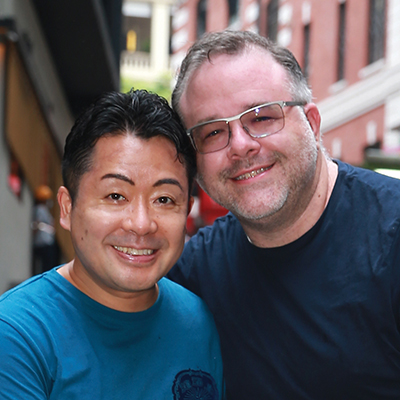 Josh Blue
Josh Blue
Hong Kong
Josh Blue ’01 was near tears when he called his parents from the bathroom at work to announce that he had resigned his job in Hong Kong. His mom said, “You are in a foreign country with no job — what are you going to do?”
He had the presence of mind to reply, “I’m a qualified teacher. Everyone needs teachers. I’ll find a new job.” And that’s exactly what he did.
Blue had planned to spend two years in Hong Kong. “Over 20 years later, I am still here,” he says. A history major with Elementary Education Certification, his positions have ranged from teacher to vice principal to his current role as principal of an international school. “I’ve discovered a passion for not only working with students, but for teachers and learning communities too,” Blue says.
Living thousands of miles from Iowa has made Blue more deliberate about maintaining his Grinnell ties. He’s part of a circle of Grinnellians in Hong Kong who stay in touch. “I don’t feel disconnected,” he says. “In some ways, by being abroad, I have to make a greater effort to stay in the loop.”
Blue’s life in Hong Kong includes his partner Taka and their son Isaac. “I’ve created a life for myself I don’t think would have been possible had I stayed stateside,” Blue says. “I am incredibly thankful.”
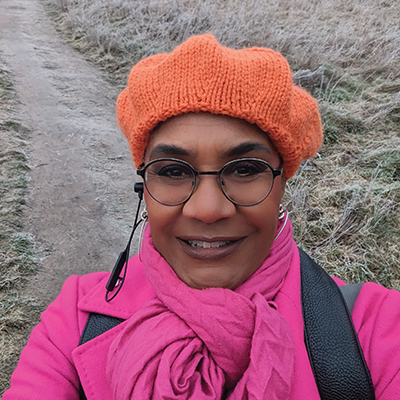 Daphne Cunningham
Daphne Cunningham
Oxford, U.K.
Grinnell-in-London was life-changing for Daphne Cunningham ’95. It marked the beginning of her love affair
with the U.K., which is now her home. The G-in-L students enjoyed performances, exhibitions, and field trips. “It was just a fabulous experience of freedom,” Cunningham says.
She has a special fondness for Donna Vinter, who ran the G-in-L program for decades. They reconnected when Cunningham returned to the U.K. to live in 2005. “We’ve been friends ever since,” she says.
Donna sometimes invited Cunningham to speak to the Grinnell students about life in the U.K. Cunningham’s Grinnell community spans borders and decades.
Keeping up with it is worth the effort, she says. “I’ve had big returns. I’ve not had a bad experience at all being in contact with Grinnell people.”
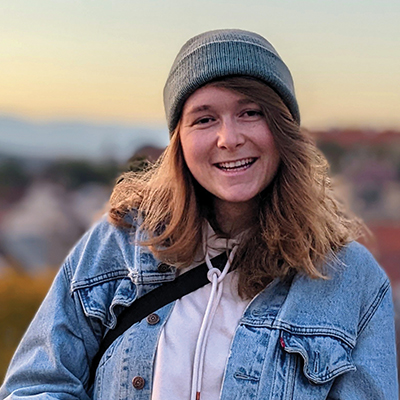 Misha Gelnarová
Misha Gelnarová
Czech Republic
For many Grinnell alumni, the friendships they forged on campus remain firmly embedded in their hearts, even years later and thousands of miles from Iowa.
“I feel like the close connection you make during your four years in (Grinnell) is just very hard to get in any other setting,” says Misha Gelnarová ’18, a native of the Czech Republic.
“It is honest, wholesome, intimate, and it runs deep,” she explains. “My Grinnell years have shaped who I am, and with Grinnellians, I am my true self — they’ve seen me at my best and worst. With them, I feel challenged and respected — I feel home.”
As an alum now who has worked in Brussels and Prague, Gelnarová says the bonds remain strong. “I think it is possible to nurture and expand your Grinnell network even thousands of miles from Iowa,” she explains.
“When a Grinnellian I know is coming to a nearby country, I take it as an excuse to meet up with as many close-by Grinnellians as possible.” She’s met up with Grinnellians in London, Berlin, Llastres (a village in northern Spain), Lisbon, Prague, Gdansk, Warsaw, and Lausanne.
The Grinnell connection doesn’t seem to fade — in fact, it often grows stronger. “That’s the most beautiful part,” Gelnarová adds. “The Grinnell sense of community extends beyond the cornfields. It is about the people, their mindset, and attitudes, about the shared lived experience.”
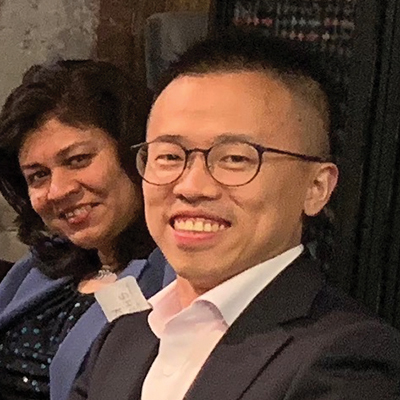 Jiazhen Chen
Jiazhen Chen
Shanghai, China
Is it possible to build a Grinnell network thousands of miles from campus? “It’s more than possible,” says Jiazhen “Jason” Chen ’07.
His Grinnell connections are both personal and professional. On a recent flight home from Malaysia, he made a stop in Singapore to hang out with a Grinnellian.
Professionally, he has hosted externs and he’s looking forward to working with Grinnellian interns in Shanghai this year. The city is also home to close-knit group of Grinnell alumni who socialize often. The Grinnell connection is real, Chen says. “It’s something we can’t see or touch — but it’s there.”
Save the Date: International Alumni Listening Sessions
Alumni Council members will facilitate virtual listening sessions for international alumni on Sunday, Sept. 10, 2023, to discuss how they engage and connect with fellow Grinnellians and the College.